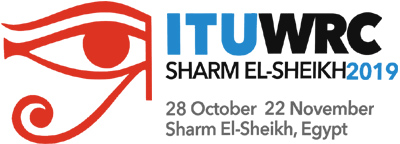 Though it may have passed most of the international news channels by, the world's radio spectrum regulators and associated government departments and ministers have just signed away the results of the 2019 World Radiocomminication Conference (WRC-19) held in Sharm El Sheikh, Egypt. This 4 week long event is where international decisions on the use of the radio spectrum take place. Or at least that's the theory. All 'decisions' have to be driven by consensus, which means that everyone must agree and with so many divergent views on topics as wide ranging as more spectrum for 5G mobile services, to globally harmonising spectrum for railway communications, there is lots to discuss. There were around 20 items on the agenda for the conference.
Though it may have passed most of the international news channels by, the world's radio spectrum regulators and associated government departments and ministers have just signed away the results of the 2019 World Radiocomminication Conference (WRC-19) held in Sharm El Sheikh, Egypt. This 4 week long event is where international decisions on the use of the radio spectrum take place. Or at least that's the theory. All 'decisions' have to be driven by consensus, which means that everyone must agree and with so many divergent views on topics as wide ranging as more spectrum for 5G mobile services, to globally harmonising spectrum for railway communications, there is lots to discuss. There were around 20 items on the agenda for the conference.Of particular interest to radio amateurs was agenda item 1.1, which concerned:
the allocation of the frequency band 50-54 MHz to the amateur service in Region 1
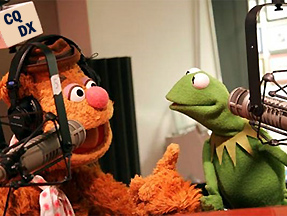 Radio amateurs have requested that the whole frequency range from 50 to 54 MHz is allocated to them on a primary basis in ITU Region 1 which is Europe, the Middle East and Africa. At present, in the ITU Radio Regulations, which dictate which frequencies are allocated to which services, 50 - 54 MHz is allocated to radio amateurs on a primary basis in Regions 2 (the Americas) and 3 (Asia/Pacific), and the idea was to align the band in every region. In Region 1 the frequencies are allocated to broadcasting as well as (in some countries) to radiolocation, land mobile and fixed (point-to-point) services, but not to radio amateurs (unless national administrations have unilaterally decided to allow them). Only in Botswana, Eswatini, Lesotho, Malawi, Namibia, the Democratic Republic of Congo, Rwanda, South Africa, Zambia and Zimbabwe does the band have any allocation to radio amateurs in the existing Radio Regulations.
Radio amateurs have requested that the whole frequency range from 50 to 54 MHz is allocated to them on a primary basis in ITU Region 1 which is Europe, the Middle East and Africa. At present, in the ITU Radio Regulations, which dictate which frequencies are allocated to which services, 50 - 54 MHz is allocated to radio amateurs on a primary basis in Regions 2 (the Americas) and 3 (Asia/Pacific), and the idea was to align the band in every region. In Region 1 the frequencies are allocated to broadcasting as well as (in some countries) to radiolocation, land mobile and fixed (point-to-point) services, but not to radio amateurs (unless national administrations have unilaterally decided to allow them). Only in Botswana, Eswatini, Lesotho, Malawi, Namibia, the Democratic Republic of Congo, Rwanda, South Africa, Zambia and Zimbabwe does the band have any allocation to radio amateurs in the existing Radio Regulations.Following the machinations at WRC-19, the radio amateurs have been granted a secondary allocation across Region 1 in the frequency range 50 - 52 MHz, with primary allocations in some or all of the range 50 - 54 MHz in a limited number of new countries. A secondary allocation means that the amateurs must not cause interference to any primary services (i.e. broadcasting and land mobile) and must accept interference from them, but it's a step forwards towards a global expansion of the 6 metre band.
This does not mean that the band will be available in each and every country immediately. First, each country's administration or regulator needs to update their national frequency allocation table to include the new band. This can take anything from a few months to a few years. There are still some countries who have not yet implemented the results of the previous WRC in 2015, despite it being completed 4 years ago. So don't hold your breath hoping to use the band when on holiday in Ouagadougou, it may be a long time before this new band is widely available.
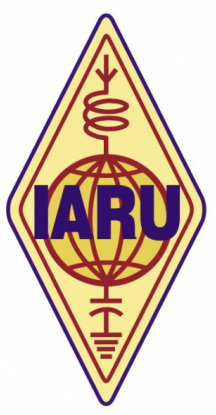 The next task for the International Amateur Radio Union (IARU) who work tirelessly on behalf of radio amateurs at events such as WRC-19 is to deal with Agenda Items 1.2 and 9.1.2 of the next WRC in 2023. Agenda Item 1.2 is entitled:
The next task for the International Amateur Radio Union (IARU) who work tirelessly on behalf of radio amateurs at events such as WRC-19 is to deal with Agenda Items 1.2 and 9.1.2 of the next WRC in 2023. Agenda Item 1.2 is entitled:to consider identification of the frequency bands ... 10.0-10.5 GHz for International Mobile Telecommunications (IMT), including possible additional allocations to the mobile service on a primary basis... (N.B. this applies in Region 2, i.e. the Americas, only)
This includes a secondary Amateur allocation between 10.0 and 10.5 GHz, and a secondary Amateur-Satellite allocation between 10.45 and 10.5 GHz (as used by the already infamous Es'Hail-2 (a.k.a. QO-100), the first geostationary satellite with an Amateur radio transponder. Whilst the allocation of the band for IMT (5G) services does not preclude the Amateur service, in reality, a band full of a dense network of base stations and handsets would make it nigh-on impossible to be used for amateur radio and the band may be lost, in exactly the same way that the 2.3 GHz and 3.4 GHz bands were.
Agenda Item 9.1.2 is entitled:
Review of the amateur service and the amateur-satellite service allocations in the frequency band 1 240-1 300 MHz to determine if additional measures are required to ensure protection of the radionavigation-satellite (space-to-Earth) service operating in the same band...
 The IARU will need to stave off pressure to remove (or otherwise reduce) the radio amateur secondary allocation on the frequencies 1240 - 1300 MHz (the 23 cm band) as it is claimed by the European Commission that amateurs may cause interference to their Galileo satellte navigation system. Not, it is worth pointing out, the everyday service used by smart phones and in-car sat-navs, but an additional service for specialist users.
The IARU will need to stave off pressure to remove (or otherwise reduce) the radio amateur secondary allocation on the frequencies 1240 - 1300 MHz (the 23 cm band) as it is claimed by the European Commission that amateurs may cause interference to their Galileo satellte navigation system. Not, it is worth pointing out, the everyday service used by smart phones and in-car sat-navs, but an additional service for specialist users. 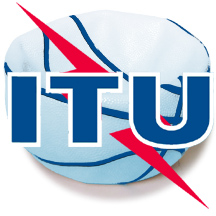 The argument goes that there was once an amateur television repeater in the band which caused interference. Once - and it was resolved very quickly. But that is enough to raise concerns of potential wider future interference problems. The Commission therefore want to throw the amateurs out of the spectrum. The amateur allocation is secondary, so they must not cause interference, and so the Galileo service is already protected, but that is not always enough for everyone. The ITU giveth with one hand, and threaten to take away with two others. Was it ever any different?
The argument goes that there was once an amateur television repeater in the band which caused interference. Once - and it was resolved very quickly. But that is enough to raise concerns of potential wider future interference problems. The Commission therefore want to throw the amateurs out of the spectrum. The amateur allocation is secondary, so they must not cause interference, and so the Galileo service is already protected, but that is not always enough for everyone. The ITU giveth with one hand, and threaten to take away with two others. Was it ever any different?add comment
( 1263 views )
| permalink
| 



 ( 3 / 21103 )
( 3 / 21103 )




 ( 3 / 21103 )
( 3 / 21103 )
The use of the radio spectrum in Europe is determined by a range of different organisations. At the truly international level, the ITU dictates which services are allocated which parts of the spectrum in its Radio Regulations which are updated every 3 to 4 years as the result of the World Radiocommunications Conference (WRC) at which every country in the world's regulators sit down and agree on any changes. At the more regional level, CEPT propose and make decisions on the use of spectrum in Europe. In the case of both the ITU and CEPT, several working groups are established to consider different topics such as fixed links, mobile services and satellite services.
 A recent meeting of CEPT/ECC Working Group PT-A which took place in June in Prague, Czechia, was considering the items that should go on the agenda of the 2023 WRC, as these need to be agreed at the 2019 WRC to be held later this year. At this meeting, the French spectrum regulator, the ANFR, updated a proposal concerning:
A recent meeting of CEPT/ECC Working Group PT-A which took place in June in Prague, Czechia, was considering the items that should go on the agenda of the 2023 WRC, as these need to be agreed at the 2019 WRC to be held later this year. At this meeting, the French spectrum regulator, the ANFR, updated a proposal concerning:
Non-safety aeronautical mobile services are likely to consist of things such as the remote control of (military) drones. As a result of this submission, the meeting has proposed an item that will be taken by CEPT member countries to the next WRC which states:
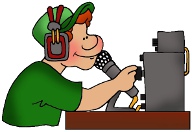 Hidden amongst this is a potential time-bomb for radio amateurs. The French administration is effectively proposing that the 2 metre amateur band (144 - 146 MHz) which is currently allocated for the exclusive use by radio amateurs, should be shared with non-safety aeronautical mobile services. Note that this is already the case in China and that in Region 1 (Europe) the spectrum immediately below the 144 MHz band is already allocate for Aeronautical Mobile services. The proposal does not state whether the new allocation should be on a secondary basis (in which case radio amateurs would continue to be protected from interference) or whether it would be on a co-primary basis (in which case both sets of users would have equivalent interference protection rights).
Hidden amongst this is a potential time-bomb for radio amateurs. The French administration is effectively proposing that the 2 metre amateur band (144 - 146 MHz) which is currently allocated for the exclusive use by radio amateurs, should be shared with non-safety aeronautical mobile services. Note that this is already the case in China and that in Region 1 (Europe) the spectrum immediately below the 144 MHz band is already allocate for Aeronautical Mobile services. The proposal does not state whether the new allocation should be on a secondary basis (in which case radio amateurs would continue to be protected from interference) or whether it would be on a co-primary basis (in which case both sets of users would have equivalent interference protection rights).
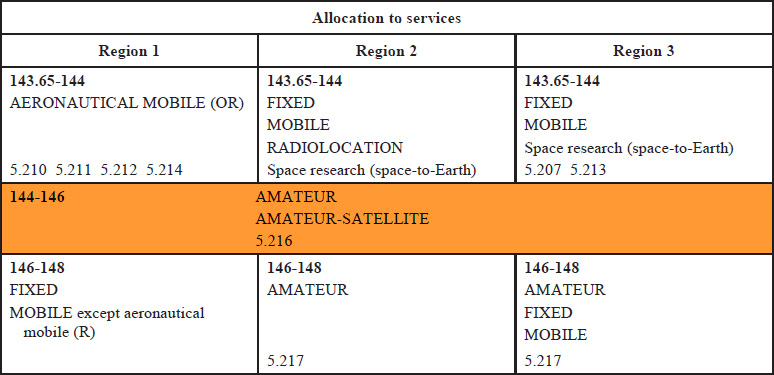
Wireless Waffle understands that the proposal was originated by French defence manufacturer Thales, and that their preferred outcome would be a co-primary allocation. Should this happen, notwithstanding the fact that there would be an interferer in the 2 metre band, the aeronautical services, if they suffered interference from amateurs, could them potential claim protection. It is not completely impossible that as a result of this, the amateur service could be either reduced to secondary status, or told to leave the band. Such an outcome would take at least 12 years, as it would first have to be put on the agenda for a future WRC (which could not be until at least 2027), then studied, before a decision could be made (at the eariest 2031).
Should radio amateurs be concerned. In a word, YES! The 2 metre band is very heavily used and is one of the only primary and exclusive amateur radio allocations that exists. A number of other amateur bands have recently been reduced or lost to other services (e.g. 2.3 GHz, 3.4 GHz) and there is also consideration of removing the amateur service from the 23cm band from 1260 to 1300 MHz to protect satellite navigation systems. However inconceivable it may be that the 2 metre band could go the same way, it is not impossible.
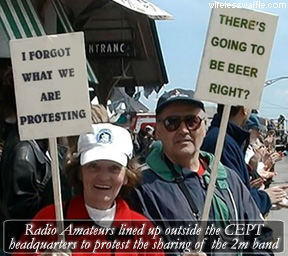 What can radio amateurs do? It is the national radio spectrum administrations who attends the CEPT/ECC meetings and represents the views of their country. In the first instance, therefore, amateurs should write to their national regulator (e.g. Ofcom in the UK) and express the importance of keeping the 2 metre band primary and exclusive for amateur use.
What can radio amateurs do? It is the national radio spectrum administrations who attends the CEPT/ECC meetings and represents the views of their country. In the first instance, therefore, amateurs should write to their national regulator (e.g. Ofcom in the UK) and express the importance of keeping the 2 metre band primary and exclusive for amateur use.
International organisations such as the IARU and national organisations such as the RSGB get involved to support the interests of radio amateurs, but this can only succeed if the national administrations listen empathetically.
If national administrations fail to support the amateur service, the next step would probably be for radio amateurs to protest outside CEPT/ECC meetings to try and demonstrate to CEPT just how strongly they object.
 A recent meeting of CEPT/ECC Working Group PT-A which took place in June in Prague, Czechia, was considering the items that should go on the agenda of the 2023 WRC, as these need to be agreed at the 2019 WRC to be held later this year. At this meeting, the French spectrum regulator, the ANFR, updated a proposal concerning:
A recent meeting of CEPT/ECC Working Group PT-A which took place in June in Prague, Czechia, was considering the items that should go on the agenda of the 2023 WRC, as these need to be agreed at the 2019 WRC to be held later this year. At this meeting, the French spectrum regulator, the ANFR, updated a proposal concerning:an agenda item for new non-safety aeronautical mobile applications.
Non-safety aeronautical mobile services are likely to consist of things such as the remote control of (military) drones. As a result of this submission, the meeting has proposed an item that will be taken by CEPT member countries to the next WRC which states:
New non-safety aeronautical mobile applications will support applications like: imagery, video, fire and border surveillance, environment monitoring, traffic/disaster monitoring. Such applications require ground to air, air to ground and air to air, communications on-board manned and unmanned aircraft. Use of innovative sharing methods may be considered to ensure the protection of existing services while offering the possibility to have access to new frequency bands. Several frequency bands are proposed for investigation within different ranges in order to meet the various operational requirements for new non-safety aeronautical mobile applications.
It is proposed to study the bands 162.0375-174.000 MHz, 862-874 MHz and 22-22.21 GHz in order to evaluate the possible revision or deletion of the "except aeronautical mobile" restriction and the bands 144-146 MHz, 5000-5010 MHz and 15.4-15.7 GHz for possible new allocations to the aeronautical mobile service.
 Hidden amongst this is a potential time-bomb for radio amateurs. The French administration is effectively proposing that the 2 metre amateur band (144 - 146 MHz) which is currently allocated for the exclusive use by radio amateurs, should be shared with non-safety aeronautical mobile services. Note that this is already the case in China and that in Region 1 (Europe) the spectrum immediately below the 144 MHz band is already allocate for Aeronautical Mobile services. The proposal does not state whether the new allocation should be on a secondary basis (in which case radio amateurs would continue to be protected from interference) or whether it would be on a co-primary basis (in which case both sets of users would have equivalent interference protection rights).
Hidden amongst this is a potential time-bomb for radio amateurs. The French administration is effectively proposing that the 2 metre amateur band (144 - 146 MHz) which is currently allocated for the exclusive use by radio amateurs, should be shared with non-safety aeronautical mobile services. Note that this is already the case in China and that in Region 1 (Europe) the spectrum immediately below the 144 MHz band is already allocate for Aeronautical Mobile services. The proposal does not state whether the new allocation should be on a secondary basis (in which case radio amateurs would continue to be protected from interference) or whether it would be on a co-primary basis (in which case both sets of users would have equivalent interference protection rights).
Wireless Waffle understands that the proposal was originated by French defence manufacturer Thales, and that their preferred outcome would be a co-primary allocation. Should this happen, notwithstanding the fact that there would be an interferer in the 2 metre band, the aeronautical services, if they suffered interference from amateurs, could them potential claim protection. It is not completely impossible that as a result of this, the amateur service could be either reduced to secondary status, or told to leave the band. Such an outcome would take at least 12 years, as it would first have to be put on the agenda for a future WRC (which could not be until at least 2027), then studied, before a decision could be made (at the eariest 2031).
Should radio amateurs be concerned. In a word, YES! The 2 metre band is very heavily used and is one of the only primary and exclusive amateur radio allocations that exists. A number of other amateur bands have recently been reduced or lost to other services (e.g. 2.3 GHz, 3.4 GHz) and there is also consideration of removing the amateur service from the 23cm band from 1260 to 1300 MHz to protect satellite navigation systems. However inconceivable it may be that the 2 metre band could go the same way, it is not impossible.
 What can radio amateurs do? It is the national radio spectrum administrations who attends the CEPT/ECC meetings and represents the views of their country. In the first instance, therefore, amateurs should write to their national regulator (e.g. Ofcom in the UK) and express the importance of keeping the 2 metre band primary and exclusive for amateur use.
What can radio amateurs do? It is the national radio spectrum administrations who attends the CEPT/ECC meetings and represents the views of their country. In the first instance, therefore, amateurs should write to their national regulator (e.g. Ofcom in the UK) and express the importance of keeping the 2 metre band primary and exclusive for amateur use. International organisations such as the IARU and national organisations such as the RSGB get involved to support the interests of radio amateurs, but this can only succeed if the national administrations listen empathetically.
If national administrations fail to support the amateur service, the next step would probably be for radio amateurs to protest outside CEPT/ECC meetings to try and demonstrate to CEPT just how strongly they object.
Monday 19 December, 2016, 13:59 - Amateur Radio, Broadcasting, Spectrum Management
Posted by Administrator
Posted by Administrator
 Wireless Waffle last discussed the issue of interference to and from wireless car keys and other similar devices back in 2013, but the topic has cropped up here almost since time immemorial. The original articles discussed the fact that the frequency band used for these devices (around 433.925 MHz) was shared with radio amateurs and that not only were the radio amateurs suffering from interference but that there were cases of car users getting stuck either unable to lock or unlock their cars due to nearby amateur radio transmissions.
Wireless Waffle last discussed the issue of interference to and from wireless car keys and other similar devices back in 2013, but the topic has cropped up here almost since time immemorial. The original articles discussed the fact that the frequency band used for these devices (around 433.925 MHz) was shared with radio amateurs and that not only were the radio amateurs suffering from interference but that there were cases of car users getting stuck either unable to lock or unlock their cars due to nearby amateur radio transmissions.But it seems that the situation has changed and that criminals have cottoned on to the fact that it's possible to jam the transmissions between cars and their keys to their benefit. The BBC reports that thieves in a car park in Berkshire had been 'using car key jammers' and also provides useful advice on the impact and implications of car key jammers.
Now far be it for Wireless Waffle to condone such activities, but it is so brain-achingly simple, and mind-bogglingly cheap, to jam these signals, that it's a surprise that it has taken criminals so long to figure out how to do it.
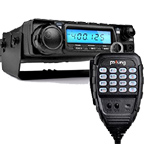 Transmissions from car key fobs normally use either amplitude modulation or fairly crude frequency modulation and the transmitters have a power level of no more than 10 milliWatts. The receivers in the vehicles are manufactured to a price point of around 50 pence and are woefully inadequate at protecting against interference. Thus, a strong enough signal on the same frequency as the car key transmitter (or indeed on a neighbouring one) will overwhealm the low power transmission from the keys. A 40 Watt transmitter (4000 times stronger than the signal from the keys) operating in the same band can be purchased on-line for little more than GBP100.
Transmissions from car key fobs normally use either amplitude modulation or fairly crude frequency modulation and the transmitters have a power level of no more than 10 milliWatts. The receivers in the vehicles are manufactured to a price point of around 50 pence and are woefully inadequate at protecting against interference. Thus, a strong enough signal on the same frequency as the car key transmitter (or indeed on a neighbouring one) will overwhealm the low power transmission from the keys. A 40 Watt transmitter (4000 times stronger than the signal from the keys) operating in the same band can be purchased on-line for little more than GBP100. Such a transmitter would be a brute force way to stop the receiver in the car from being able to hear the signal from the key. This would stop the key from being able to lock the car, meaning that an unsuspecting driver could get out of the car and casually press the button on their key and walk away without listening for the corresponding 'clunk' of the car locking, not realising that the car has not locked. This would clearly leave the car unlocked and easy pickings for a thief.
In principal it would be easy to go one stage further. With a simple receiver it would be possible to record the transmission from the key, and using a low power transmitter, it would be feasible to re-create the signal. In this case, it would be possible for a criminal to unlock a car after it had been safely locked by the driver. Don't say we didn't warn you.
 This is not just possible for car keys, but for any devices which operate in a similar manner. The 433 MHz band used for these devices is replete with a variety of signals from wireless devices such as garage doors, parking barriers and devices for which an attack would be less significant such as weather stations and doorbells. The chart below (known as a waterfall chart) shows, from top to bottom, around 2 minutes of time, and from left to right, the middle portion of the 433 MHz band. A wide range of different transmissions are shown as bars or dots and it is clear there's plenty afoot here despite the transmission area of the devices being very small and thus the limited number of devices in range of the receiver used to perform this scan.
This is not just possible for car keys, but for any devices which operate in a similar manner. The 433 MHz band used for these devices is replete with a variety of signals from wireless devices such as garage doors, parking barriers and devices for which an attack would be less significant such as weather stations and doorbells. The chart below (known as a waterfall chart) shows, from top to bottom, around 2 minutes of time, and from left to right, the middle portion of the 433 MHz band. A wide range of different transmissions are shown as bars or dots and it is clear there's plenty afoot here despite the transmission area of the devices being very small and thus the limited number of devices in range of the receiver used to perform this scan. 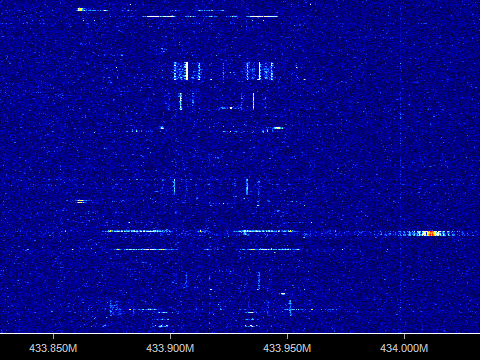
As the number and variety of wireless devices increases, in particular as we progress to the world of the 'Internet of Things' in which there will be sensors and actuators everywhere, it is clear that the security of wireless connections needs beefing up. If you are concerned about your car being 'hacked' by criminals, the best way is to disable the convenience of the wireless key locks and return to the old-fashioned technique of putting the key for your car into the door. Sadly, some modern cars don't actually have this feature any more!
Thursday 22 January, 2015, 10:48 - Amateur Radio, Broadcasting, Licensed, Radio Randomness, Spectrum Management
Posted by Administrator
Radio amateurs with designs on operating from the planet Mars are appealing against a decision by the Consultative Committee for Space Data Systems (CCSDS) to allocate the 70 cm amateur band (430 - 440 MHz +/-) for communications between satellites in orbit around the red planet and the numerous rovers that criss-cross its surface. Posted by Administrator
In a statement, released by the Mars United People for Planetary and Earth Transmissions (MUPPETs), tea-drinking general secretary Arthur Dent said,
MUPPETs have been planning a DX-pedition to Mars for some time. To discover that our officially allocated radio frequencies are already in use is just not fair. It constrains our ability to talk about radio stuff to each other and means other radio amateurs around the solar-system will be denied extra points in the forthcoming 'talking about radio stuff with other radio nuts' contest.
Responding to the accusations, Prostetnic Vogon Jeltz of the CCSDS commented,
The 70cm frequency band has been used for communications on and off Mars since the Viking lander first set foot on the planet back in 1976. The MUPPETs have had plenty of time to comment. The plans for frequency use on Mars have been available at the local planning office on Alpha Century for fifty of your Earth years, so they've had plenty of time to lodge any formal complaints and it's far too late to start making a fuss about it now. I'm sorry but if they can't be bothered to take an interest in local affairs that's their own regard.
Appallingly obvious references to the Hitch-Hikers Guide to the Galaxy aside, it may surprise many people to learn that there is, indeed, a frequency plan for Mars. And that there are already 5 communication satellites in orbit around the planet! For communication from the rovers on the surface to the orbiting satellites, frequencies in the range 390 to 405 MHz are used. For the link down from the orbiters to the rovers, the frequency range 435 - 450 MHz is used, which falls inside the amateur radio 70cm band.
The choice of the particular frequencies in use (on Mars) is designed to try and stop anyone deliberately causing interference from the Earth, whilst retaining ease of use on Mars (i.e. the ability to use omni-directional antennas). The various satellites orbiting Mars typically get no nearer than around 400 km from the surface and communication with rovers typically takes place when the satellites make their closest pass. The shortest distance between the Earth and Mars is typically around 60 million km. The table below shows the path-loss at 415 MHz of these distances.
| Route | Distance | Path Loss |
|---|---|---|
| Satellite to Mars surface | 400 km | 137 dB |
| Earth to Mars | 60,000,000 km | 240 dB |
So the difference in path loss is just over 100 dB. For a transmitter to cause interference from the Earth to communication on Mars, it would therefore have to have a radiated transmitter power 100 dB higher than the signals passing between the rovers and the satellites.
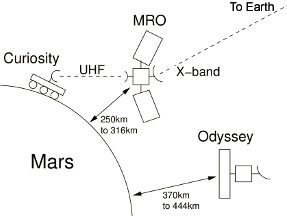 A very good description of the communications with Mars is provided by Steven Gordon (from whom the diagram on the left is shamelessly plagiarised). The transmitter power used on Mars is 5 Watts (7 dBW), so in order to cause interference from Earth, a transmitter power of around 107 dBW, or 50,000,000,000 Watts (a.k.a. 50 GigaWatts) would be required. Would it be possible to generate such a signal?
A very good description of the communications with Mars is provided by Steven Gordon (from whom the diagram on the left is shamelessly plagiarised). The transmitter power used on Mars is 5 Watts (7 dBW), so in order to cause interference from Earth, a transmitter power of around 107 dBW, or 50,000,000,000 Watts (a.k.a. 50 GigaWatts) would be required. Would it be possible to generate such a signal?Firstly, it ought to be possible to generate at least 100,000 Watts (100 kiloWatts or 50 dBW) of power at the necessary frequencies as television transmitters for the UHF band that reach this level are available. So what is then required is an antenna with a gain of 57 dB. This requires a dish with a diameter of around 150 metres. The largest dish antenna in the world is the radio telescope at Arecibo, Puerto Rico, which is 305 metres in diameter.
 If a high powered television transmitter was therefore connected up to the Arecibo radio telescope antenna, it ought to be more than possible to jam the transmissions between the Mars rovers and the orbiting satellites during periods where the Earth and Mars were closely aligned. Of course this kind of power level is way beyond the normal licensing conditions of a typical radio amateur and the right conditions would occur roughly every 2 to 3 years when the Earth and Mars come closer together. Nonetheless, commenting on this finding, Arthur Dent of the MUPPETs jeered,
If a high powered television transmitter was therefore connected up to the Arecibo radio telescope antenna, it ought to be more than possible to jam the transmissions between the Mars rovers and the orbiting satellites during periods where the Earth and Mars were closely aligned. Of course this kind of power level is way beyond the normal licensing conditions of a typical radio amateur and the right conditions would occur roughly every 2 to 3 years when the Earth and Mars come closer together. Nonetheless, commenting on this finding, Arthur Dent of the MUPPETs jeered,Safe from interference, eh? Who looks silly now then Jeltz!

